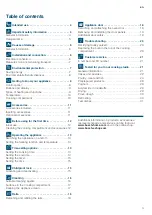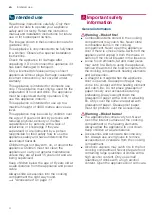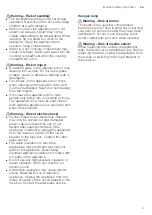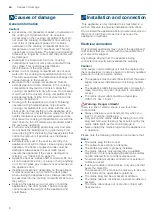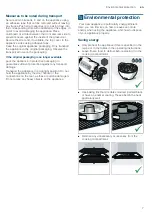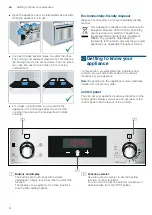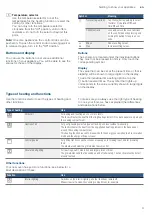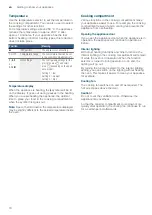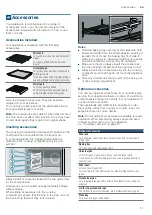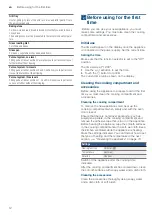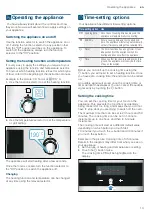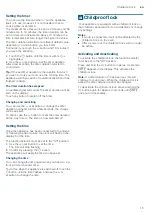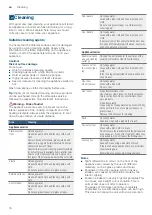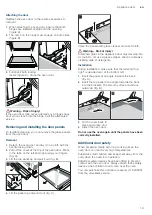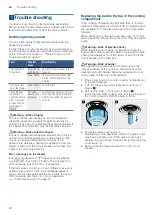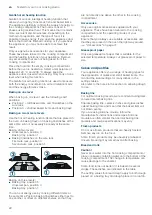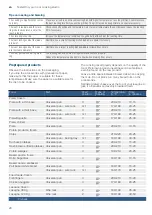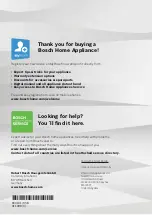
en
Cleaning
16
D
Cleaning
Cleaning
With good care and cleaning, your appliance will retain
its appearance and remain fully functioning for a long
time to come. We will explain here how you should
correctly care for and clean your appliance.
Suitable cleaning agents
To ensure that the different surfaces are not damaged
by using the wrong cleaning agent, observe the
information in the table. Depending on the appliance
model, not all of the areas listed may be on/in your
appliance.
Caution!
Risk of surface damage
Do not use:
■
Harsh or abrasive cleaning agents,
■
Cleaning agents with a high alcohol content,
■
Hard scouring pads or cleaning sponges,
■
High-pressure cleaners or steam cleaners,
■
Special cleaners for cleaning the appliance while it is
hot.
Wash new sponge cloths thoroughly before use.
Tip:
Highly recommended cleaning and care products
can be purchased through the after-sales service.
Observe the respective manufacturer's instructions.
:
Warning – Risk of burns!
The appliance becomes very hot. Never touch the
interior surfaces of the cooking compartment or the
heating elements. Always allow the appliance to cool
down. Keep children at a safe distance.
--------
Notes
■
Slight differences in colour on the front of the
appliance are caused by the use of different
materials, such as glass, plastic and metal.
■
Shadows on the door panels, which look like
streaks, are caused by reflections made by the
interior lighting.
■
Enamel is baked on at very high temperatures.This
can cause some slight colour variation. This is
normal and does not affect operation.
The edges of thin trays cannot be completely
enamelled. As a result, these edges can be rough.
This does not impair the anti-corrosion protection.
Area
Cleaning
Appliance exterior
Stainless steel
front
Hot soapy water:
Clean with a dish cloth and then dry with a soft
cloth.
Remove flecks of limescale, grease, starch and
albumin (e.g. egg white) immediately. Corrosion
can form under such flecks.
Special stainless steel cleaning products suitable
for hot surfaces are available from our after-sales
service or from specialist retailers. Apply a very
thin layer of the cleaning product with a soft cloth.
Plastic
Hot soapy water:
Clean with a dish cloth and then dry with a soft
cloth.
Do not use glass cleaner or a glass scraper.
Painted surfaces Hot soapy water:
Clean with a dish cloth and then dry with a soft
cloth.
Control panel
Hot soapy water:
Clean with a dish cloth and then dry with a soft
cloth.
Do not use glass cleaner or a glass scraper.
Door panels
Hot soapy water:
Clean with a dish cloth and then dry with a soft
cloth.
Do not use a glass scraper or a stainless steel
scouring pad.
Door handle
Hot soapy water:
Clean with a dish cloth and then dry with a soft
cloth.
If descaler comes into contact with the door han-
dle, wipe it off immediately. Otherwise, any stains
will not be able to be removed.
Appliance interior
Enamel surfaces
and self-cleaning
surfaces
Observe the instructions for the surfaces of the
cooking compartment that follow the table.
Glass cover for
the interior light-
ing
Hot soapy water:
Clean with a dish cloth and then dry with a soft
cloth.
If the cooking compartment is heavily soiled, use
oven cleaner.
Door seal
Do not remove.
Hot soapy water:
Clean with a dish cloth.
Do not scour.
Door cover
made from stainless steel:
Use stainless steel cleaner. Follow the manufac-
turers' instructions. Do not use stainless steel
care products.
made from plastic:
Clean using hot soapy water and a dish cloth. Dry
with a soft cloth. Do not use glass cleaner or a
glass scraper.
Remove the door cover for cleaning.
Rails
Hot soapy water:
Soak and clean with a dish cloth or brush.
Pull-out system
Hot soapy water:
Clean with a dish cloth or a brush.
Do not remove the lubricant while the pull-out rails
are pulled out – it is best to clean them when they
are pushed in. Do not clean in the dishwasher.
Accessories
Hot soapy water:
Soak and clean using a dishcloth or brush.
If there are heavy deposits of dirt, use a stainless
steel scouring pad.
Enamelled accessories are dishwasher-safe.
Cleaning
en
17
Surfaces in the cooking compartment
The back wall in the cooking compartment is self-
cleaning.You can tell this from the rough surface.
The base, ceiling and side panel are enamelled and
have smooth surfaces.
Cleaning enamel surfaces
Clean the smooth enamel surfaces with a dish cloth
and hot soapy water or a vinegar solution. Then dry
them with a soft cloth.
Soften baked-on food remnants with a damp cloth and
soapy water. Use stainless steel wire wool or oven
cleaner to remove stubborn dirt.
Caution!
Never use oven cleaner in the cooking compartment
when it is still warm. This may damage the enamel.
Remove all food remnants from the cooking
compartment and the appliance door before you next
heat up the appliance.
Leave the cooking compartment open to dry after
cleaning it.
Note:
Food residues can cause white deposits to form.
These are harmless and do not affect how the
appliance works. You can remove these residues using
lemon juice if required.
Cleaning self-cleaning surfaces
The self-cleaning surfaces are coated with a porous,
matte ceramic layer. This coating absorbs and dispels
splashes from baking and roasting while the appliance
is in operation.
If the self-cleaning surfaces no longer clean themselves
sufficiently and dark stains appear, they can be cleaned
using targeted heating.
Making settings
Remove the rails, pull-out shelves, accessories and
ovenware from the cooking compartment beforehand.
Thoroughly clean the smooth enamel surfaces in the
cooking compartment, the inside of the appliance door
and the glass cover on the interior lighting.
1.
Set the 3D hot air type of heating.
2.
Set the maximum temperature.
3.
Start the mode and leave it to run for at least one
hour.
The ceramic coating is regenerated.
When the cooking compartment has cooled down,
remove the brown or white residue with water and a soft
sponge.
Note:
During operation, reddish spots form on the
surfaces. This is not rust, but residues from food. These
spots are not harmful and do not restrict the cleaning
ability of the self-cleaning surfaces.
Caution!
Do not use oven cleaner on the self-cleaning surfaces.
This will damage the surfaces.If oven cleaner does get
onto these surfaces, dab it off immediately using water
and a sponge cloth. Do not rub the surface and do not
use abrasive cleaning aids.
Keeping the appliance clean
Always keep the appliance clean and remove dirt
immediately so that stubborn deposits of dirt do not
build up.
:
Warning – Risk of fire!
Loose food remnants, fat and meat juices may catch
fire. Before using the appliance, remove the worst of the
food remnants from the cooking compartment, heating
elements and accessories.
Tips
■
Clean the cooking compartment after each use. This
will ensure that dirt cannot be baked on.
■
Always remove flecks of limescale, grease, starch
and albumin (e.g. egg white) immediately.
■
Use the universal pan for baking very moist cakes.
■
Use suitable ovenware for roasting, e.g. a roasting
dish.
Summary of Contents for HHF133B.0B
Page 2: ......

